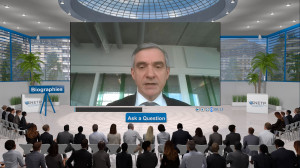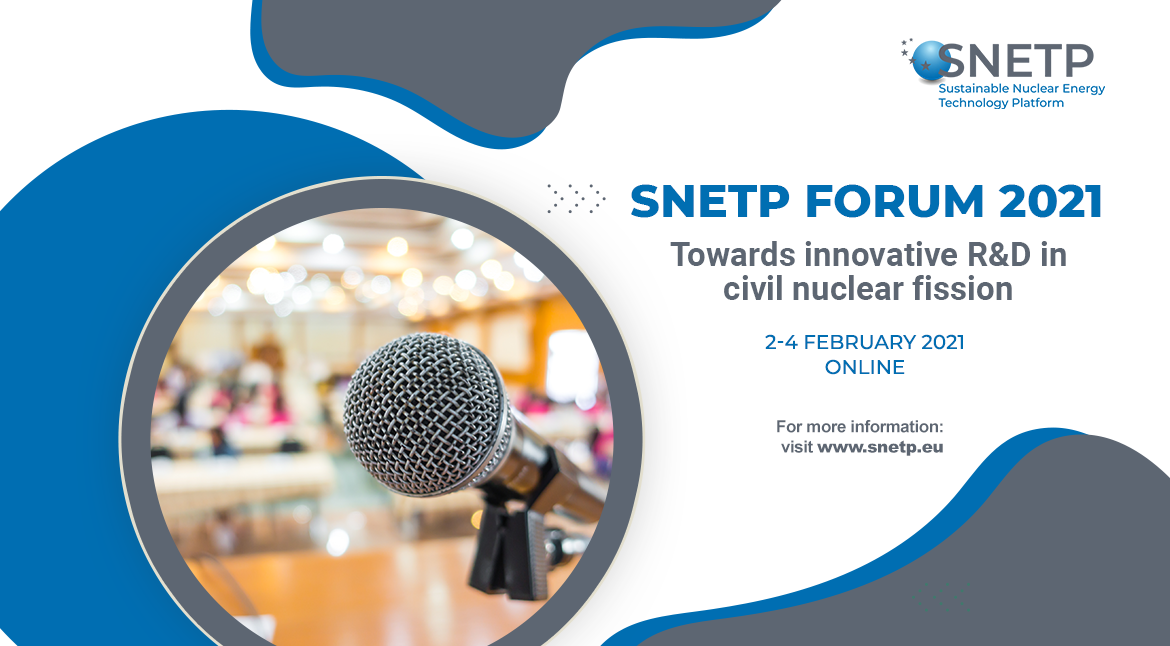The SNETP FORUM 2021 was held on 2-4 February in a virtual format. Over 630 participants, not only from all European countries but also from Japan, USA, Canada, Ukraine, and Argentina, were actively involved during the three-day event dedicated to innovation R&D in civil nuclear fission.
Plenary

SNETP President, Bernard Salha (EDF), officially launched the event by welcoming the audience and presenting the SNETP Association. “We are the largest collaborative platform in Europe working in nuclear research and innovation. We gather the major R&D organisations involved in nuclear in Europe and beyond and we work together to improve nuclear efficiency, safety and performance”, he stated.
Bernard Salha gave an overview of SNETP objectives: promoting scientific excellence in nuclear research, boosting innovation, representing nuclear fission R&D in European affairs, strengthening international relations with nuclear institutions, providing solutions to industry, cooperating closely with regulators, supporting R&D infrastructure, sharing experience with European associations and engaging with civil society. “We aim to contribute to the shaping of European energy policies, especially in the nuclear field, by exchanging with relevant actors about research priorities and producing reference documents, such as the SNETP Strategic Research and Innovation Agenda (SRIA)”, he said. He also briefly presented the SNETP Pillars: ESNII on Generation IV Fast Neutron Reactor technologies, NC2I on nuclear cogeneration and NUGENIA on Generation II and III reactor technologies; and the SNETP committees, each one of them working towards a specific SNETP objective.
Following this introduction, SNETP Pillars Chairmen described the activities of NUGENIA, ESNII and NC2I. Steve Napier (NIRO/UK), NUGENIA Chairman, introduced the overall objectives of the pillar and presented each NUGENIA technical area focusing on the specific challenges faced. He concluded his presentation with an overview of what NUGENIA has achieved and the remaining actions. Marc Schyns (SCK.CEN/Be), ESNII Interim Chairman, presented the ESNII Vision Paper that will contain a mission and vision statement, an overall strategy and a list of goals and objectives. Finally, Józef Sobolewski (NCBJ/Pl), NC2I Chairman, presented the mission and vision of the pillar, with a focus on nuclear cogeneration activities in Poland. A detailed vision of the three SNETP pillars will be published in April this year.
The day continued with a panel session. In his introduction to this session and after welcoming the invitees, the president Bernard Salha, welcomed the opportunity to exchange views on the resilience of the nuclear sector in this historic moment both from the sanitary view point (the covid is getting even stronger nowadays) and also from the climate side. He insisted by saying “Our common goal is provide solutions to tackle this huge challenge facing us all now and will be even more dramatic for the generations to come if we do not do anything about it right now”.
Bernard Salha pointed out that “The European nuclear industry and its R&I community have a long history of providing excellence and benefit to European citizens. Nuclear energy is indispensable in areas such as tackling climate change, as it is currently the largest single supplier of flexible, low-carbon electricity in EU and enables continuous security of supply by ensuring independence from third countries. But nuclear technology is more than just a power supplier: it plays an indispensable role in the medical sector, particularly in terms of diagnosis and treatment of cancer (thus supporting Europe’s Beating Cancer Plan), as well as in industry, space, agriculture, etc. Nuclear is also a place of innovation for new digital applications (such as artificial intelligence, block chain, IOT,..) as well as for operation and security of the European electrical grid together with variable renewables and storage. By developing innovative and cross-cutting applications, nuclear serves a wide range of R&I domains which the EU is focusing on”.
He ended up his introduction saying that “SNETP, with its 120 members from industry, research centers, academia and SMEs, aims to strengthen cross-sectoral collaboration to facilitate innovation in nuclear and to support the maintenance and enhancement of skills and qualifications to address the key challenges facing the sector”.
Michael Chudakov, Deputy Director General and Head of the Department of Nuclear Energy at the IAEA, highlighted the role of collaborative research, innovation and development to increase the contribution of nuclear power to climate change mitigation, energy security and energy poverty alleviation. “None of this can be done without international cooperation and collaboration on innovation and R&D with key international partners”, he said.
William Magwood, Director-General, OECD Nuclear Energy Agency (NEA) discussed about how the R&D community can best help the new build to be successful in the future. During his intervention he highlighted the outcome of the report the NEA published last year, Unlocking Reductions in the Construction Costs of Nuclear: A Practical Guide for Stakeholders: “One of the most important areas examined in this report is how digital technology can help, and when I’m asked what can nuclear research do, I say that looking at digital technologies is the single most important thing that can be done by the technical community at this point”.
Sama Bilbao, Director General of the World Nuclear Association, focused her presentation on the role of nuclear energy in climate change mitigation. She compared the impact of climate change on the nuclear industry with the impact of Covid-19 on the pharmaceutical industry and asked for a paradigm and attitude change to accelerate the deployment of cost-effective nuclear technologies. Sama Bilbao also stressed the need for government support to increase innovation in the nuclear industry.
Yves Desbazeille, Director General of FORATOM, presented nuclear’s contribution to Europe’s economy in terms of electricity production – nuclear accounts for 50% of EU’s decarbonised electricity –, and jobs creation – nuclear provides over 1 million jobs in the EU. He also gave an overview of the role for nuclear in decarbonisation: “The first objective is to ensure a proper long-term operation of the existing fleet to move towards a decarbonised future. In the long run it is also important to invest in new build with an objective of 15% nuclear generation for 2050“.
Rosalinde VAN DER VLIES, Director of the Clean Planet Directorate in the European Commission’s, Directorate-General for Research and Innovation, re-contextualised her intervention within the framework of the European Green Deal: “Sustainability and competitiveness issues really go hand in hand. With the European Green Deal, the European Commission (EC) has for the first time explicitly said that sustainability strategy is also our growth strategy and contributes to our competitiveness”. Rosalinde VAN DER VLIES stated that strong investments in research and innovation will be required to achieve climate neutrality by 2050 and emissions reduction targets of 55% by 2030. She also highlighted a few novelties of the new Euratom work programme: “In the area of fission, our objective is to foster cross sector innovation linked to non-power applications. It will also be a priority to improve safety in fuel management, radioactive waste and decommissioning. Finally, we will also focus on having more synergies with Horizon Europe, in particular in training activities”, she stated.
Nicolas Février, Director at EDF- Nuclear Engineering and New Build Projects Division – Design and Technology Branch, presented nuclear power as a low carbon energy solution for global warming mitigation. “It is very important for EDF to be a key player in the target of reaching carbon neutrality. We are convinced that nuclear, apart from being carbon free, is a dispatchable energy that is resilient, very cost-efficient and will be a pillar of the carbon neutrality we are committed to”, he said. Nicolas Février also highlighted two lessons drawn from the covid crisis: Europe needs to secure its independence in a number of strategic domains, such as medicine and electricity generation; and once the crisis is solved, the development of new nuclear power plant projects will be a good way to establish a rapid economic recovery and to boost local employment.
To conclude, SNETP President shared the Association’s vision to tackle climate change: “SNETP believes the best solution to fight climate change is to combine a variety of technologies, including nuclear energy and renewables emitting the lowest possible amount of greenhouse gases, to hold the increase of global temperature below 1.5 degrees by 2050, in coherence with the recommendations of many international organisations. This is a position based on scientific and technical facts which are at the heart of our Association”. In this sense he called for political support, strong investments and strengthened cross sector collaboration to reach these objectives.
SNETP technical sessions
The second and third days of the SNETP FORUM 2021 were dedicated to technical sessions on a variety of topics of interest for the nuclear community (a short summary of each of the sessions will be published in the proceedings soon):
- The first technical session, moderated by Pavel Kral (UJV) and Luis Herranz (CIEMAT), looked at long term operation and construction, focusing on topics such as hydrogen management, implementation of safety requirements in the post-Fukushima period, perspectives and opportunities for LTO in Europe, etc.
- The second technical session, moderated by Eric Hanus (CEA) and Rob Arnold (BEIS), discussed SMRs, with several presentations addressing passive safety.
- The third technical session, moderated by Steve Napier (NIRO) and Bruno Michel (CEA), addressed fuel development and fuel cycle efficiency. Presentations covered aspects such as fuel performance, simulation of fuel behaviour in accidental conditions and fuel recycling and sustainability.
- The fourth technical session, moderated by Lorenzo Malerba (CIEMAT) and Karl-Fredrik Nilsson (JRC), talked about innovative and perspective materials solutions, with a focus on nuclear applications.
- The fifth technical session energy systems, moderated by Marc Deffrennes (weCARE) and Franck Carré (CEA), examined energy systems, new applications, economy and licensing. Some of the topics addressed in this session were the decarbonisation, the role of nuclear in the future energy mix and green hydrogen.
- The sixth technical session, moderated by Erika Holt (VTT) and Anthony Banford (NNL), focused on decommissioning & waste treatment. This session featured two roundtable discussions on the priorities for decommissioning R&D projects and the priorities for radwaste R&D cooperative projects. In addition, two EU projects from SNETP portfolio were presented: the PLEIADES and the SHARE project.
- The seventh technical session, moderated by Paul Schuurmans (SCK-CEN) and Nathan Paterson (Foratom), dealt with advanced reactor systems. Some of ESNII industrial initiatives, such as ALFRED and ALLEGRO were presented. The MYRRHA R&D project in support to the ESNII technologies was also introduced.
- The eighth technical session, moderated by Ferry Roelofs (NRG) and Didier Banner (EDF), looked at digitalisation, modelling and simulation as a relatively new field of expertise covering aspects such as code development, machine learning, code qualification, uncertainty quantification, code coupling, digital twins and virtual reactors.
SNETP FORUM recordings and presentations
If you would like to replay the plenary and the technical sessions, please access the event online platform that will be open until 5 March 2021. There you will also be able to download the factsheets from the SNETP projects portfolio and leave your feedback on the SNETP FORUM 2021.
All public presentations from the Forum can be now downloaded HERE.

